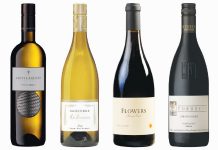Story by Charles Fredy
It wasn’t that long ago that organic wines weren’t taken seriously. Wine aficionados didn’t care about the process; they just wanted a delicious wine. But with the growing popularity of organic food, there’s a new “cool” factor to organic wines, as well.
The truth is, a lot of wine producers have always used organic practices. In Europe, growers plant fig trees among the grapevines; insects that would otherwise attack the grapes are attracted to the figs, instead. And setting sheep to graze among the vines reduces the need for herbicides to control weeds.
Whether a vintner can go completely organic depends on many factors. In vineyards close to rivers or subject to lots of moisture, mold can be a big problem. A more pervasive issue is that wine producers often have to buy fruit from various sources to create the best-tasting blends, and going organic limits their choices. If your estate vineyard is certified organic, but you need to blend your fruit with grapes that aren’t, you can’t add “organic” to your label.
What’s a wine lover to do? Read the label carefully, and do a little research. Only a few organizations, such as the Department of Agriculture (USDA) and California Certified Organic Farmers (CCOF), can certify that a vineyard is organic. If the label says “organically grown,” it means the winery has used only natural, organic methods in growing the fruit. But that doesn’t automatically mean the wine has been produced organically; the vintner may have had to add sulfur to the grapes during fermentation. If you want to be sure that both the grapes and the winemaking methods were organic, look for the label that says “organic wine.”
Neither label guarantees that the wine will taste great—and consumers are wise to recognize when a vineyard is marketing itself as organic just to jump on the bandwagon. (One winery we know recently received CCOF certification for one of its vineyards, but most of its wines aren’t from that single vineyard.) Still, most reputable wineries want to produce a better wine, and do so forever—and that starts with responsible farming. My advice? Choose wineries that follow sustainable, organic or biodynamic farming practices, whether or not they’re labeled “organic.” Even if the wine you drink isn’t 100 percent organic, you can choose selections that come close. Here are some I recommend:
+ Ponzi, Pinot Gris, Willamette Valley, Oregon, 2007,
sustainably grown
+ Arrowood Winery, Sonoma County, Chardonnay, 2005,
organically grown
+ Clos Pegase, Chardonnay, Napa Valley, 2006,
organically grown
+ Domaine Leflaive, Macon Verze, Burgundy, 2006,
biodynamically grown
+ Domaine Carneros, Pinot Noir, Napa Valley, 2006,
organically grown
+ Neal Family Vineyards, Petite Sirah, Napa Valley, 2005,
organically grown
+ Burgess, Merlot, Napa Valley, 2005,
organically grown





